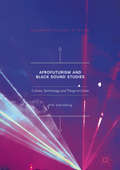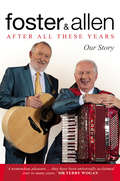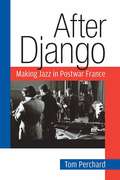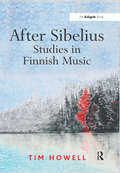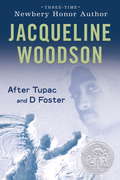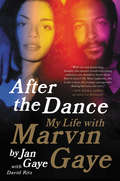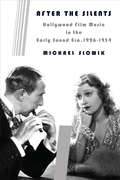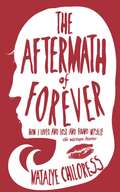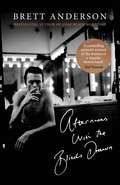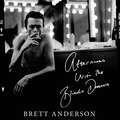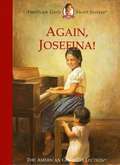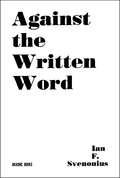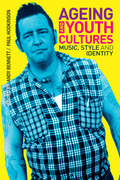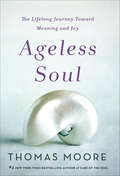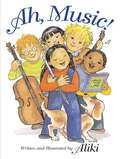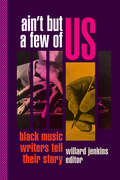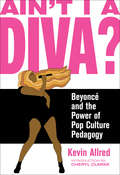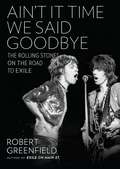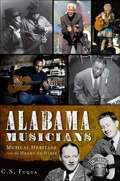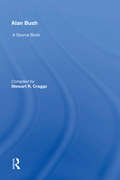- Table View
- List View
Afrofuturism and Black Sound Studies: Culture, Technology, and Things to Come (Palgrave Studies in Sound)
by Erik SteinskogThis book interrogates the meeting point between Afrofuturism and Black Sound Studies. Whereas Afrofuturism is often understood primarily in relation to science fiction and speculative fiction, it can also be examined from a sonic perspective. The sounds of Afrofuturism are deeply embedded in the speculative - demonstrated in mythmaking - in frameworks for songs and compositions, in the personas of the artists, and in how the sounds are produced. In highlighting the place of music within the lived experiences of African Americans, the author analyses how the perspectives of Black Sound Studies complement and overlap with the discussion of sonic Afrofuturism. Focusing upon blackness, technology, and sound, this unique text offers key insights in how music partakes in imagining and constructing the future. This innovative volume will appeal to students and scholars of sound studies, musicology and African American studies.
After All These Years: Our Story
by Tony Allen Mick FosterThis is the combined life story of Mick Foster and Tony Allen, revealing how these most unlikely of stars toured the world and entered the record books. A charming narrative told with heaps of Celtic charm, it is filled with nostalgic reminiscences about growing up in rural Ireland in the 1950s and 60s, and spans the breadth of their long career, including appearing on Top of the Pops alongside Bob Geldof and being feted by Terry Wogan, and the extraordinary moment when they found themselves at the very top of the charts, beating Take That to the number-one slot.
After Django: Making Jazz In Postwar France
by Tom PerchardHow did French musicians and critics interpret jazz--that quintessentially American music--in the mid-twentieth century? How far did players reshape what they learned from records and visitors into more local jazz forms, and how did the music figure in those angry debates that so often suffused French cultural and political life? After Django begins with the famous interwar triumphs of Josephine Baker and Django Reinhardt, but, for the first time, the focus here falls on the French jazz practices of the postwar era. The work of important but neglected French musicians such as André Hodeir and Barney Wilen is examined in depth, as are native responses to Americans such as Miles Davis and Thelonious Monk. The book provides an original intertwining of musical and historical narrative, supported by extensive archival work; in clear and compelling prose, Perchard describes the problematic efforts towards aesthetic assimilation and transformation made by those concerned with jazz in fact and in idea, listening to the music as it sounded in discourses around local identity, art, 1968 radicalism, social democracy, and post colonial politics.
After Mahler
by Stephen DownesThe music of Gustav Mahler repeatedly engages with Romantic notions of redemption. This is expressed in a range of gestures and procedures, shifting between affirmative fulfilment and pessimistic negation. In this groundbreaking study, Stephen Downes explores the relationship of this aspect of Mahler's music to the output of Benjamin Britten, Kurt Weill and Hans Werner Henze. Their initial admiration was notably dissonant with the prevailing Zeitgeist – Britten in 1930s England, Weill in 1920s Germany and Henze in 1950s Germany and Italy. Downes argues that Mahler's music struck a profound chord with them because of the powerful manner in which it raises and intensifies dystopian and utopian complexes and probes the question of fulfilment or redemption, an ambition manifest in ambiguous tonal, temporal and formal processes. Comparisons of the ways in which this topic is evoked facilitate new interpretative insights into the music of these four major composers.
After Sibelius: Studies in Finnish Music
by Tim HowellDuring the last twenty years, the rest of the world has come to focus on the music of Finland. The seemingly disproportionate creative energy from this small country defies prevalent trends in the production of classical music. Tim Howell provides an engaging investigation into Finnish music and combines elements of composer biography and detailed analysis within the broader context of cultural and national identity. The book consists of a collection of eight individual composer studies that investigate the historical position and compositional characteristics of a representative selection of leading figures, ranging from the beginning of the twentieth century to the present day. These potentially self-contained studies subscribe to a larger picture, which explains the Sibelian legacy, the effect of this considerable influence on subsequent generations and its lasting consequences: an internationally acclaimed school of contemporary music. Outlining a particular perspective on modernism, Howell provides a careful balance between biographical and analytical concerns to allow the work to be accessible to the non-specialist. Each composer study offers a sense of overview followed by progressively more detail. Close readings of selected orchestral works provide a focus, while the structure of each analysis accommodates the different levels of engagement expected by a wide readership. The composers under consideration are Aarre Merikanto, Erik Bergman, Joonas Kokkonen, Einojuhani Rautavaara, Aulis Sallinen, Paavo Heininen, Kaija Saariaho and Magnus Lindberg. The concluding discussion of issues of national distinctiveness and the whole phenomenon of why such a small nation is compositionally so active, is of wide-ranging significance. Drawing together various strands to emerge from these individual personalities, Howell explores the Finnish attitude to new music, in both its composition and reception, uncovering an enlightened view of the value of creativity from which
After Tupac and D Foster
by Jacqueline WoodsonD Foster showed up a few months before Tupac got shot that first time and left us the summer before he died. <P><P> The day D Foster enters Neeka and her best friend's lives, the world opens up for them. D comes from a world vastly different from their safe Queens neighborhood, and through her, the girls see another side of life that includes loss, foster families and an amount of freedom that makes the girls envious. Although all of them are crazy about Tupac Shakur's rap music, D is the one who truly understands the place where he's coming from, and through knowing D, Tupac's lyrics become more personal for all of them. The girls are thirteen when D's mom swoops in to reclaim D--and as magically as she appeared, she now disappears from their lives. Tupac is gone, too, after another shooting; this time fatal. As the narrator looks back, she sees lives suspended in time, and realizes that even all-too-brief connections can touch deeply. <P> A Discussion Guide to After Tupac and D Foster by Jacqueline Woodson .<P> Newbery Honor book
After the Dance
by David Ritz Jan GayeA searing memoir of love, drugs, sex, and old-school R&B, from the former wife of the legendary soul icon Marvin GayeStuck in a foster home with an abusive caregiver, Janis Hunter found solace in her dreams of an encounter with Marvin Gaye--the soulful prince of Motown, with the seductive liquid voice, whose chart-topping, socially conscious album What's Going On had recently made him a superstar.They met in February 1973. Despite a seventeen-year age difference and Marvin's marriage to the sister of Berry Gordy, Motown's founder, the enchanted teenager and the emotionally volatile singer began a scorching relationship. One moment Jan was a high school student, the next she was Marvin's soulmate. Their romance navigated the hippie high life of the seventies and took the couple from one adventure to another.But the distractions and burdens of fame, the chaos of dysfunctional families, and the irresistible temptation of drugs complicated the love they shared. Marvin and Jan hurt each other, and their relationship descended into a dark place, but the attraction was too magnetic and the love was too strong to let go. Largely silent since Marvin's tragic death in 1984, Jan has at last opened up, sharing the moving, passionate story of one of music history's most fabled relationships. Unsparing in its honesty and insight, After the Dance reveals what it's like to be in love with an artistic genius, a man whose words and music have touched the world and made him a legend.
After the Silents
by Michael SlowikViewing more than two hundred films from the period, Michael Slowik launches the first comprehensive study of a long-neglected phase in Hollywood's initial development
After the Silents: Hollywood Film Music in the Early Sound Era, 1926-1934 (Film and Culture Series)
by Michael SlowikMany believe Max Steiner's score for King Kong (1933) was the first important attempt at integrating background music into sound film, but a closer look at the industry's early sound era (1926–1934) reveals a more extended and fascinating story. Viewing more than two hundred films from the period, Michael Slowik launches the first comprehensive study of a long-neglected phase in Hollywood's initial development, recasting the history of film sound and its relationship to the "Golden Age" of film music (1935–1950). <P><P>Slowik follows filmmakers' shifting combinations of sound and image, recapturing the volatility of this era and the variety of film music strategies that were tested, abandoned, and kept. He explores early film music experiments and accompaniment practices in opera, melodrama, musicals, radio, and silent films and discusses the impact of the advent of synchronized dialogue. He concludes with a reassessment of King Kong and its groundbreaking approach to film music, challenging the film's place and importance in the timeline of sound achievement.
Aftermath of Forever: How I Loved and Lost and Found Myself. The Mix Tape Diaries (Punx Ser.)
by Natalye ChildressThe Aftermath of Forever: How I Loved and Lost and Found Myself is a memoir that chronicles the romantic coming-of-age of a woman in her 20s experiencing dating in the San Francisco Bay Area. After the disappointment of a failed marriage, Natalye Childress embarks on a soul-searching journey to discover what happens when the one you thought you would be with forever breaks your heart. Using music as a vehicle to express herself, she revisits ten men from her past and paints a portrait of their relationships through the mixtapes she has made them. Her quest for love takes the form of delving into the hedonistic world of noncommittal beaus, abusive boyfriends, and friends with benefits. She candidly dissects her love life on the page as she shares the inspiring and hopeful moments alongside the awkward and painful realizations that accompany dating in the present day, when everyone is looking for something different. These men, although they leave her life almost as quickly as they entered it, collectively help shape her future as she embarks on a quest not only to find love, but to find herself. Ultimately, she learns the age-old lesson that in order to truly be loved, she needs to first love herself.
Afternoons with the Blinds Drawn
by Brett Anderson'A compelling personal account of the dramas of a singular British band' Neil TennantThe trajectory of Suede - hailed in infancy as both 'The Best New Band in Britain' and 'effete southern wankers' - is recalled with moving candour by its frontman Brett Anderson, whose vivid memoir swings seamlessly between the tender, witty, turbulent, euphoric and bittersweet. Suede began by treading the familiar jobbing route of London's emerging new 1990s indie bands - gigs at ULU, the Camden Powerhaus and the Old Trout in Windsor - and the dispiriting experience of playing a set to an audience of one. But in these halcyon days, their potential was undeniable. Anderson's creative partnership with guitarist Bernard Butler exposed a unique and brilliant hybrid of lyric and sound; together they were a luminescent team - burning brightly and creating some of the era's most revered songs and albums.In Afternoons with the Blinds drawn, Anderson unflinchingly explores his relationship with addiction, heartfelt in the regret that early musical bonds were severed, and clear-eyed on his youthful persona. 'As a young man . . . I oscillated between morbid self-reflection and vainglorious narcissism' he writes. His honesty, sharply self-aware and articulate, makes this a compelling autobiography, and a brilliant insight into one of the most significant bands of the last quarter century.
Afternoons with the Blinds Drawn
by Brett Anderson'A compelling personal account of the dramas of a singular British band' Neil TennantThe trajectory of Suede - hailed in infancy as both 'The Best New Band in Britain' and 'effete southern wankers' - is recalled with moving candour by its frontman Brett Anderson, whose vivid memoir swings seamlessly between the tender, witty, turbulent, euphoric and bittersweet. Suede began by treading the familiar jobbing route of London's emerging new 1990s indie bands - gigs at ULU, the Camden Powerhaus and the Old Trout in Windsor - and the dispiriting experience of playing a set to an audience of one. But in these halcyon days, their potential was undeniable. Anderson's creative partnership with guitarist Bernard Butler exposed a unique and brilliant hybrid of lyric and sound; together they were a luminescent team - burning brightly and creating some of the era's most revered songs and albums.In Afternoons with the Blinds drawn, Anderson unflinchingly explores his relationship with addiction, heartfelt in the regret that early musical bonds were severed, and clear-eyed on his youthful persona. 'As a young man . . . I oscillated between morbid self-reflection and vainglorious narcissism' he writes. His honesty, sharply self-aware and articulate, makes this a compelling autobiography, and a brilliant insight into one of the most significant bands of the last quarter century.
Afternoons with the Blinds Drawn
by Brett Anderson'A compelling personal account of the dramas of a singular British band' Neil TennantThe trajectory of Suede - hailed in infancy as both 'The Best New Band in Britain' and 'effete southern wankers' - is recalled with moving candour by its frontman Brett Anderson, whose vivid memoir swings seamlessly between the tender, witty, turbulent, euphoric and bittersweet. Suede began by treading the familiar jobbing route of London's emerging new 1990s indie bands - gigs at ULU, the Powerhaus and the Old Trout in Windsor - and the dispiriting experience of playing a set to an audience of one. But in these halcyon days, their potential was undeniable. Anderson's creative partnership with guitarist Bernard Butler exposed a unique and brilliant hybrid of lyric and sound; together they were a luminescent team - burning brightly and creating some of the era's most revered songs and albums.In Afternoons with the Blinds drawn, Anderson unflinchingly explores his relationship with addiction, heartfelt in the regret that early musical bonds were severed, and clear-eyed on his youthful persona. 'As a young man . . . I oscillated between morbid self-reflection and vainglorious narcissism' he writes. His honesty, sharply self-aware and articulate, makes this a compelling autobiography, and a brilliant insight into one of the most significant bands of the last quarter century.
Again Josefina (American Girls Short Stories #8)
by Valerie TrippAny child who has taken piano lessons will get a kick out of this book. Josefina finds unique ways to "practice," and even baby Antonio gets into the act of encouraging her to practice more. Humor, warmth, and lots of repetition lead Josefina to become a player of songs. Other books about Josefina are also available from Bookshare. In order for this file to make an excellent embossed braille copy, attention must be paid to the words written in Spanish.
Against the Written Word: Toward A Universal Illiteracy
by Ian F. SvenoniusIf the Gutenberg Bible is the alpha, Against the Written Word is the OMEGA. Against the Written Word is the most important, most revolutionary book produced since the advent of the printing press; the book that will liberate readers from reading, writers from writing, and booksellers from peddling their despicable wares. This book ushers in a new era of freedom from reading and all its attendant bedfellows such as Enlightenment thinking and the mass alienation wrought by the phonetic alphabet. Against the Written Word will be a tremendous best seller and simultaneously the last book that anyone will read. With nineteen essays ripping, shredding, tearing apart all the bugaboos that haunt humanity nowadays, Against the Written Word is a must-read for any aspiring radical or would-be gnostic who has a penchant for words, thought, clothes, intoxicants, music, art, expression, etc. The work is presented in a range of writing: essays, screenplays, lectures, sci-fi stories, and manifestos, with topics that include “the rise of incorporated man,” “tourism as the neoliberal mode of military occupation,” a workshop on songwriting for the purpose of suggestion and mind control, and many more. This handsome, illustrated book will correct the paucity of thought that characterizes the modern bookstore, and will practically sell itself. It will call out from the shelf to ingratiate itself to the unsuspecting everyday book browser, who will be hooked and then hungrily consume it. Infected with a wild-eyed evangelism, they will then proliferate it amongst their friends and acquaintances. These new readers will disseminate it, and so on; soon this slim, innocuous volume will define an epoch and steer thought from here on out. The bookseller will be surprised and pleased to find that it will be the only book they need to stock. Against the Written Word will be dominant in a manner the market has not seen since the Bible tore up best-seller lists in the Middle Ages or Mao’s Little Red Book wowed the critics in Red China.
Ageing and Youth Cultures: Music, Style and Identity
by Paul Hodkinson Andy BennettWhat happens to punks, clubbers, goths, riot grrls, soulies, break-dancers and queer scene participants as they become older? For decades, research on spectacular 'youth cultures' has understood such groups as adolescent phenomena and assumed that involvement ceases with the onset of adulthood. In an age of increasingly complex life trajectories, Ageing and Youth Cultures is the first anthology to challenge such thinking by examining the lives of those who continue to participate into adulthood and middle-age. Showcasing a range of original research case studies from across the globe, the chapters explore how participants reconcile their continuing involvement with ageing bodies, older identities and adult responsibilities. Breaking new ground and establishing a new field of study, the book will be essential reading for students and scholars researching or studying questions of youth, fashion, popular music and identity across a wide range of disciplines.
Ageless Soul: The Lifelong Journey Toward Meaning and Joy
by Thomas MooreAgeless Soul will teach readers how to embrace the richness of experience and how to take life on, accept invitations to new vitality, and feel fulfilled as they get older.Thomas Moore is the renowned author of Care of the Soul, the classic #1 New York Times bestseller. In Ageless Soul, Moore reveals a fresh, optimistic, and rewarding path toward aging, one that need not be feared, but rather embraced and cherished. In Moore’s view, aging is the process by which one becomes a more distinctive, complex, fulfilled, loving, and connected person. Using examples from his practice as a psychotherapist and teacher who lectures widely on the soul of medicine and spirituality, Moore argues for a new vision of aging: as a dramatic series of initiations, rather than a diminishing experience, one that each of us has the tools—experience, maturity, fulfillment—to live out. Subjects include:*Why melancholy is a natural part of aging, and how to accept it, rather than confuse it with depression *The vital role of the elder and mentor in the lives of younger people*The many paths of spiritual growth and learning that open later in life*Sex and sensuality *Building new communities and leaving a legacy
Aging and Popular Music in Europe (Routledge Studies in Popular Music)
by Abigail Gardner Ros JenningsOpening up the dialogue between popular music studies and aging studies, this book offers a major exploration of age and popular music across Europe. Using a variety of methods to illustrate how age within popular music is contingent and compelling, the volume explores how it provokes curation and devotion across a variety of sites and artists who record in several European languages, and genres including waltz music, electronica, pop, folk, rap, and the French ‘chanson.’ Visiting the many ways in which age is problematized, revered, and performed within Europe in relation to popular music, case studies analyze: French touring shows of popular music stars from the 1960s; André Rieu’s annual Vrijthof concerts in the Netherlands; Kraftwerk and Björk’s appearances at renowned art museums as curated objects; queer approaches to popular music space and time; British folk music inheritances; pan-European strategies of stardom and career longevity; and inheritance and post-colonial hauntings of race and identity. The book works with the notion of travelling, across borders, genres, sexualities, and media, highlighting the visibility of the aging body across a variety of European sites in order to establish popular music through the lens of age as a positive methodology with which to approach popular music cultures, and to offer a counter-narrative to age as decline. This book will appeal to scholars of popular music, popular culture, media studies, cultural studies, aging studies, and cultural gerontology.
Ah, Music!
by Aliki<P>Surveys the history and components of music, concentrating on Western musical traditions. <P>[This text is listed as an example that meets Common Core Standards in English language arts in grades 2-3 at http://www.corestandards.org.]
Ain't But a Few of Us: Black Music Writers Tell Their Story
by Willard JenkinsDespite the fact that most of jazz’s major innovators and performers have been African American, the overwhelming majority of jazz journalists, critics, and authors have been and continue to be white men. No major mainstream jazz publication has ever had a black editor or publisher. Ain’t But a Few of Us presents over two dozen candid dialogues with black jazz critics and journalists ranging from Greg Tate, Farah Jasmine Griffin, and Robin D. G. Kelley to Tammy Kernodle, Ron Welburn, and John Murph. They discuss the obstacles to access for black jazz journalists, outline how they contend with the world of jazz writing dominated by white men, and point out that these racial disparities are not confined to jazz but hamper their efforts at writing about other music genres as well. Ain’t But a Few of Us also includes an anthology section, which reprints classic essays and articles from black writers and musicians such as LeRoi Jones, Archie Shepp, A. B. Spellman, and Herbie Nichols.ContributorsEric Arnold, Bridget Arnwine, Angelika Beener, Playthell Benjamin, Herb Boyd, Bill Brower, Jo Ann Cheatham, Karen Chilton, Janine Coveney, Marc Crawford, Stanley Crouch, Anthony Dean-Harris, Jordannah Elizabeth, Lofton Emenari III, Bill Francis, Barbara Gardner, Farah Jasmine Griffin, Jim Harrison, Eugene Holley Jr., Haybert Houston, Robin James, Willard Jenkins, Martin Johnson, LeRoi Jones, Robin D. G. Kelley, Tammy Kernodle, Steve Monroe, Rahsaan Clark Morris, John Murph, Herbie Nichols, Don Palmer, Bill Quinn, Guthrie P. Ramsey Jr., Ron Scott, Gene Seymour, Archie Shepp, Wayne Shorter, A. B. Spellman, Rex Stewart, Greg Tate, Billy Taylor, Greg Thomas, Robin Washington, Ron Welburn, Hollie West, K. Leander Williams, Ron Wynn
Ain't I a Diva?: Beyoncé and the Power of Pop Culture Pedagogy
by Kevin Allred&“[Allred] interrogates Beyoncé&’s music and videos to explore the complicated spaces where racism, sexism, and capitalism collide.&” —Kirkus Reviews In 2010, Professor Kevin Allred created the university course &“Politicizing Beyoncé&” to both wide acclaim and controversy. He outlines his pedagogical philosophy in Ain&’t I a Diva?, exploring what it means to build a syllabus around a celebrity. Topics range from a capitalist critique of &“Run the World (Girls)&” to the politics of self-care found in &“Flawless&”; Beyoncé&’s art is read alongside black feminist thinkers including Kimberlé Crenshaw, Octavia Butler, and Sojourner Truth. Combining analysis with classroom anecdotes, Allred attests that pop culture is so much more than a guilty pleasure, it&’s an access point—for education, entertainment, critical inquiry, and politics.&“Proving himself a worthy member of the BeyHive, Kevin Allred takes us on a journey through Beyoncé&’s greatest hits and expansive career—peeling back their multiple layers to explore gender, race, sexuality, and power in today&’s modern world. A fun, engaging, and important read for long-time Beyoncé fans and newcomers alike.&” —Franchesca Ramsey, author of Well, That Escalated Quickly&“Ain&’t I a Diva? explores the phenomenon of Beyoncé while explicitly championing not only her immense talent and grace but what we can learn from it. In this celebration of Beyoncé, and through her, other Black women, Allred is giving us room to be exactly who we are so that maybe we, too, can stop the world then carry on!&” —Keah Brown, author of The Pretty One&“A must-read for any fan of Beyoncé and of fascinating feminist discourse.&” —Zeba Blay, senior culture writer, HuffPost
Ain't It Time We Said Goodbye: The Rolling Stones on the Road to Exile
by Robert GreenfieldFor ten days in March 1971, the Rolling Stones traveled by train and bus to play two shows a night in many of the small theaters and town halls where their careers began. No backstage passes. No security. No sound checks or rehearsals. And only one journalist allowed. That journalist now delivers a full-length account of this landmark event, which marked the end of the first chapter of the Stones’ extraordinary career. Ain’t It Time We Said Goodbye is also the story of two artists on the precipice of mega stardom, power, and destruction. For Mick and Keith, and all those who traveled with them, the farewell tour of England was the end of the innocence. Based on Robert Greenfield’s first-hand account and new interviews with many of the key players, this is a vibrant, thrilling look at the way it once was for the Rolling Stones and their fans#151;and the way it would never be again.
Air Castle of the South: WSM and the Making of Music City
by Craig HavighurstStarted by the National Life and Accident Insurance Company in 1925, WSM became one of the most influential and exceptional radio stations in the history of broadcasting and country music. WSM gave Nashville the moniker "Music City USA" as well as a rich tradition of music, news, and broad-based entertainment. With the rise of country music broadcasting and recording between the 1920s and '50s, WSM, Nashville, and country music became inseparable, stemming from WSM's launch of the Grand Ole Opry, popular daily shows like Noontime Neighbors, and early morning artist-driven shows such as Hank Williams on Mother's Best Flour. Sparked by public outcry following a proposal to pull country music and the Opry from WSM-AM in 2002, Craig Havighurst scoured new and existing sources to document the station's profound effect on the character and self-image of Nashville. Introducing the reader to colorful artists and businessmen from the station's history, including Owen Bradley, Minnie Pearl, Jim Denny, Edwin Craig, and Dinah Shore, the volume invites the reader to reflect on the status of Nashville, radio, and country music in American culture.
Alabama Musicians: Musical Heritage from the Heart of Dixie (Music Ser.)
by C.S. FuquaIn the late 1960s and early 1970s, legendary artists like Aretha Franklin, the Rolling Stones, Willie Nelson and Bob Dylan traveled to North Alabama to record with the Muscle Shoals Rhythm section, also known as the Swampers. But Alabama hasn't just attracted musical stars with its talent--it also has a history of creating stars of its own. Join author and musician C.S. Fuqua as he showcases the breadth of Alabama's musical talent through the profiles and stories of its historic performers and innovators. From the "father of the blues," W.C. Handy, to Hank Williams, the originator of modern country music, to folk music hero Odetta and everyone in between, this is an unprecedented compendium of Alabama's groundbreaking music makers.
Alan Bush: A Source Book
by Stewart R. CraggsBorn in 1900, Alan Bush, the English composer, conductor and pianist, studied with Corder and Matthay, and privately with John Ireland. He was appointed professor of harmony and composition at the Royal Academy of Music in 1925, a post he held until 1978. In 1929-31, he continued to study at Berlin University and had piano lessons with Moiseiwitsch and Schnabel. The present Source Book documents his works (many of which reflect his Communist sympathies) and the many arrangements of music by other composers. A wealth of detail is provided, including printed scores, CD recordings, bibliographical material and manuscript scores and their locations, the majority of which have been deposited recently in the British Library by the Bush family. A chronology of the composer's life draws on many sources including letters and scrapbooks.
